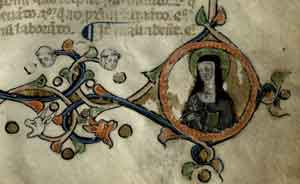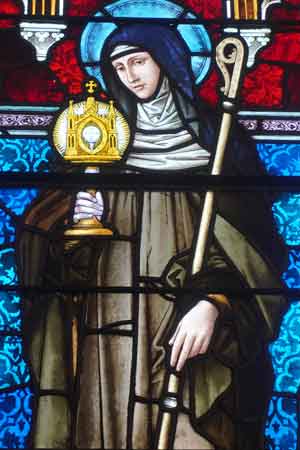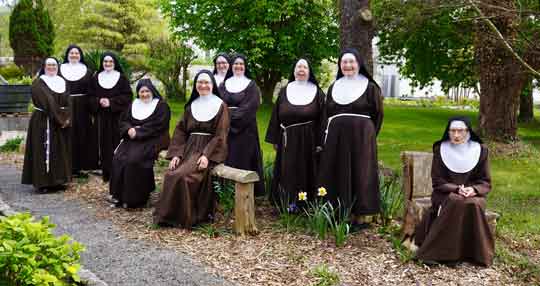COMPREHENDING CONTEMPLATION—THE POOR CLARE ORDER IN IRELAND
Published in Features, Issue 2 (March/April 2023), Volume 31By Bronagh Ann McShane

Above: Detail from the dedication page of Opus moralium distinctionum, c. 1320, showing a Poor Clare nun. (Mícheál O Cléirigh Institute/UCD-OFM partnership)
‘When Cromwell left [Ireland] … he put Ireton in charge of his soldiers. Ireton came to Galway in 1652 and demanded “surrender”. Galway yielded after many months. Then Ireton’s soldiers entered the city. It is believed that the soldiers came near a Poor Clare Convent, and they made the nuns flee from the convent. The nuns entered the river Corrib. The soldiers thought that these people would die, but their cloaks spread out in the water and the nuns were carried to safety on the opposite bank. After the incident this place was known as Nun’s Island.’
This account, recorded by schoolboy Patrick Doyle in 1938, forms part of the Irish Folklore Commission’s ‘Schools’ Collection’, a series of written interviews conducted with more than 50,000 primary school children in Ireland and recorded between 1937 and 1939. The miraculous survival of the Poor Clare nuns, as described by Doyle, occurred during the seizure of Galway by Cromwellian troops in spring 1652. The capitulation of the town marked the final stage of Oliver Cromwell’s military conquest of Ireland. Waged between 1649 and 1653, this was a brutal and destructive campaign which was to have long-term social, political and economic repercussions.
NUNS’ ISLAND
Oliver Cromwell—or Cromail in the Irish-language sources—is, not surprisingly, a figure that looms large in the Irish Folklore Collection, appearing more often than any other historical figure apart from Daniel O’Connell. Very often Cromwell is mentioned in connection with acts of violence or brutality committed against members of religious orders, both male (priests, monks, friars and canons) and female (nuns). Often accounts of violence perpetrated against nuns can be vague and nondescript—for example, they don’t mention a particular religious house or order with which the women were associated—but Patrick Doyle’s account is noteworthy for its precision in naming both the order of nuns involved, the Poor Clares, and their subsequent association with the place in Galway city known as Nuns’ Island.
The Poor Clare nuns described by Doyle were tangible historical figures who surmounted extraordinary obstacles in the process of pursuing a religious way of life and whose existence has left a lasting legacy on the environments in which they lived. Indeed, the continued presence today of the Poor Clare community at Nuns’ Island in Galway is testament to the tenacity and perseverance of their seventeenth-century predecessors. The Nuns’ Island community that exists today traces a direct lineage to the small group of Poor Clares who first gathered in the city almost four centuries ago, in 1642, while the Nuns’ Island site remains at the heart of Galway’s rich cultural heritage.
ORIGINAL FOUNDATION
The Poor Clare order is one of the most austere in the Roman Catholic Church. Founded in the thirteenth century by St Clare of Assisi (1194–1253) as the Order of the Poor Ladies, it later became known as the Order of Poor Clare and spread rapidly across western Europe. As their name suggests, the fundamental rule of the Poor Clares, like that of the Franciscan friars, their religious brethren, is poverty. They live by alms alone, accepting no endowments of either property or money. The Poor Clares, like other monastic orders, are bound by vows of poverty, chastity and obedience, professed before ecclesiastical superiors. Members of the order remain strictly enclosed within the convent cloister and live a life of austerity, which includes the observation of penance, silent contemplation and prayer. In the case of the Galway community, they belong to a group of Poor Clares known as Colettines—that is to say that they follow the constitutions of St Colette of Corbie (1381–1447), which dictate a more rigorous adherence to the vow of poverty together with an emphasis on asceticism.
The Poor Clare Order first came to Ireland in 1629, when a group of seven sisters, originally professed at an English Poor Clare convent in Gravelines, established a foundation at Merchant’s Quay in Dublin. This was the first community of enclosed women to be re-established in Ireland since the suppression of the monasteries during the reign of King Henry VIII a century earlier, but their presence in Dublin was to be short-lived. Moved on by Dublin Castle authorities by 1630, the sisters later established a house called Bethlehem on the banks of Lough Ree near Athlone. It was from this Bethlehem house that the Galway house was founded in 1642.
GALWAY FOUNDATION
On 30 January 1642 the Franciscan provincial, Fr Anthony Mac Geoghegan, granted permission for a group of sisters to ‘inaugurate and erect a convent’ in Galway. Led by Helen Martin, who was the ‘abbess elect’, the community in Galway consisted of two novices and twelve professed sisters. The women were from well-known Galway families, many of them members of the long-established mercantile families known as the ‘Tribes’. Sister Mary Bonaventure Browne is undoubtedly the best known. She was the daughter of the prominent Galway merchant Andrew Browne. Her grandfather was Oliver Brown, elected mayor of Galway in 1609 but immediately deposed for refusing to take the Oath of Supremacy; her father was deposed for the same reason upon being elected sheriff of Galway in 1632. That year Mary, together with her sister Catherine, entered the Poor Clare convent in Bethlehem and from there moved back to Galway a decade later in 1642.
The Galway foundation appears to have flourished at the outset, aided as it was by strong support from the local Catholic élite. Initially the Galway sisters rented a small premises in the centre of the town. There, within two years of their arrival, they attracted as many as 23 postulants, who were ‘brought up and educated in their regular observance, not omitting in the least any of the great religion and good education they received in Bethlehem’. Among these were two sisters, Elise and Elizabeth Skerrett, daughters of one Edmond Skerrett from Aughrim, Co. Galway. A letter from the provincial, Anthony Mac Geoghegan, on 28 July 1643 recommended their admission to the Poor Clare foundation subject to the payment of the appropriate dowries, which combined amounted to £300. A formal agreement signed by the girls’ father in August 1644 recorded that the dowries were to be paid in annual instalments of £30 and that the sisters were to have no further claim on the family property after profession.
NEW CONVENT … BUT NOT FOR LONG
In mid-1649 Mary Browne, in her position as abbess, petitioned Galway Corporation for permission to build a new convent on a site just west of the town walls. In her petition, signed ‘Mary Bonaventure, unworthy abbesse’, she outlined the hardships faced by the community, including the threat of imminent eviction:
‘… through necessity by reason of the tymes their parents and friends are unable to furnish their wants as in peacable tymes the have intended, and that your poore petitioners doe suffer much by the exorbitant rent they pay, and notwithstanding their due payment, are to be thrust out of their dwelling next May, their lease being ended’.
On 10 July 1649 Galway Corporation granted the Poor Clares permission to build a convent with a garden and orchard attached on ‘Islannaltenage’, known today as ‘Nuns’ Island’. The sisters’ presence here would prove short-lived, however. Following a period of plague—which reached Galway in 1649—and siege warfare, the town surrendered to Cromwellian forces in April 1652. The Poor Clares, like their religious brethren the Franciscans and other communities of women religious in the town, including the recently established (1646) convent of Dominican nuns, were compelled to avail of the terms of surrender and depart for the Continent. Members of the Poor Clare community dispersed to Bilbao and Orduña, as well as to the university towns of Salamanca, Valladolid, Madrid and Malaga. Among those who fled was Mary Browne, who penned her chronicle account of the order while living in exile in the convent of El Caballero de Gracia in Madrid, where she died c. 1694.
REVIVAL
While some members of the community left Galway, others opted to remain (in direct contravention of the Cromwellian edict ‘commanding all nuns, of whatsoever condition, to marry or quit the kingdom’). They included Mother Mary Gabriel Martin, who remained living clandestinely in the town throughout the later decades of the seventeenth century, probably sheltered in the private residences of friends and family. By the early 1680s the community had been revived; in 1684 the abbess received permission from the Franciscan provincial to receive new novices into the community, although with the stipulation that it be done ‘privately, however, and without any great solemnity’. The outbreak of the Williamite Wars (1688–91) meant that the Poor Clares were once again obliged to disperse and many left Ireland. As in the 1650s, a small number remained living clandestinely in the town, although it was not always possible for them to live on Nuns’ Island, the site originally acquired in 1649.
By the beginning of the eighteenth century the Galway community had once again been revived, occupying a premises in Market Street in the town centre. In 1712 such was the strength and growing prosperity of the Galway house (which by then numbered more than 40 members) that a decision was taken to open a convent in Dublin. Led by six Galway sisters, among them Mary Augustine Lynch, an offshoot convent was established in the capital, first at Channel Row, on the site of a former Benedictine convent, and later in North King Street.
THE POOR CLARES TODAY
While the Dublin North King Street community was subsequently dissolved in 1834 (owing to financial difficulties), the Galway house survived. Today, the convent remains on the same Nuns’ Island site originally granted to the community by Galway Corporation in 1649. There the sisters continue to observe a lifestyle of contemplation governed by the Rule of their founder, St Clare of Assisi, and the constitutions of St Colette of Corbie. This involves a rigorous regime of prayer, fasting and household chores. In January 2017 the community marked its 375th anniversary with the celebration of Mass (in the convent chapel), officiated by the Franciscan Provincial Fr Hugh McKenna OFM and attended by members of the local Galway Franciscans.
Although deeply connected to their history, in recent years the Galway Poor Clares have embraced modern technology as a means of expanding their prayer mission. Indeed, the community has been particularly active on social media, holding their own dedicated Facebook page, YouTube channel and Soundcloud account. With over 23,000 followers on Facebook and 1.9K subscribers on YouTube, the Galway Poor Clares are very much at the vanguard of recent directives from Pope Francis, which encourage communities of contemplative nuns worldwide to engage with social media ‘for the sake of information, formation or work’ (‘II. The Means of Communication’, Cor Orans, 2018). In this fast-paced digital age, the ability of this enclosed contemplative community to embrace these new methods is testament to the adaptability and resilience which were the hallmarks of their predecessors.
Bronagh Ann McShane is a historian of women, religion and gender based at the Department of History, University of Limerick.
Further reading
M.-L. Coolahan, Women, writing and language in early modern Ireland (Oxford, 2010).
H. Concannon, The Poor Clares in Ireland, AD 1629–AD 1929 (Dublin, 1929).
B.A. McShane, Irish women in religious orders, 1530–1700: suppression, migration and reintegration (Woodbridge, 2022).


















